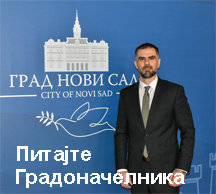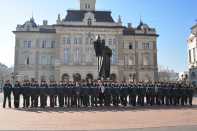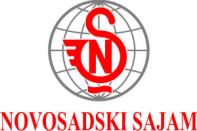HISTORY OF NOVI SAD

The ”Gibraltar on the Danube”
Novi Sad is one of the three largest cities in Serbia, and only an hour’s drive from Belgrade. Although it has never entered any competition for the most beautiful town in the country, if such a contest existed, it could easily win the Grand Prix. Novi Sad also owes its beauty and grace to its inhabitants who in this era of fast communications have preserved the tranquility of lowlanders and natural kindness. Under the Petrovaradin Rock, a little Pannonia hill of Mt. Fruska Gora, a young town on the Danube was born – Novi Sad, in existence for a little bit over 300 years. First references to it date from 1694, two years after the construction of Austria’s Petrovaradin Fortress had begun. There, at the ”Gibraltar of the Danube”, on the 1,255th kilometer of this river, the medieval Hapsburg monarchy had risen from the ashes by building this Fortress, after the Turkish siege of Vienna in 1683 had been fought off. In the place where the three rivers meet – the Danube, the Tisa, and the Sava, and so do three civilizations – those of Christian East and of Christian West and of Islam, many ethnic and religious communities found shelter and sanctuary. The place saw the Gepids, Huns, Avars, Slavs, Germanic peoples, Magyars, Byzantines, Turks… On the Petrovaradin Rock, Romans had erected a fortress, which was later rebuilt by the Hungarians and kept by the Turks. After the Turks had been expelled at the end of the 17th century, the Austrians built a bridgehead facing the fortress, on the left, marshy bank of the Danube, around which a settlement of soldiers, merchants, and tradesmen developed. In the beginning, the settlement was named Racko Selo (’Serbian Village’), and later Petrovaradinski Sanac (’Petrovaradin Trench’). As the town grew, after the wars had ended in early 18th century, the townspeople, eager to get their freedom, succeeded in gaining the status of a FREE ROYAL CITY, after paying a buy-off amount of 80,000 Forint; the status was granted by Empress Maria Theresa, and the name acquired was, in Serbian version, NOVI SAD. The date was February 1, 1748.
Where are the bridges?
The Danube has always been both rewarding and punitive-natured to Novi Sad. It was generous in that it supplied Novi Sad with drinking water and brought ships full of passengers, goods, and ideas. Its punitive nature showed with floods. In earlier centuries, the Danube had been crossed by pontoon bridges. In the 20th century, ten bridges were built over the river. The bridges would be destroyed during wars. Following the 1999 NATO air campaign, the citizens of Novi Sad would ’boast’ of their many bridges: two OVER the Danube, one (pontoon) ON the Danube, and seven IN the Danube.
”Serbian Athens”
From the very beginning, Novi Sad was a multiethnic town. Serbs have always made the majority of its population, but there were others, too: Germans, Hungarians, Croats, Slovaks, Ruthenias, Greeks, Tzintzars, Jews, Armenians, Romanians, Roma people and others. This multicultural image has not changed. In the 18th century, a traveler wrote about Novi Sad: ”The town is a remarkable example of what tolerance and trade can result in.” From 1748 onwards, a freely elected Magistrate ruled the town. At the said time, Novi Sad had 4,620 inhabitants. According to an agreement made between the Serbs and other citizens, Orthodox and Catholic representatives alternately held the main offices in city administration. In early 19th century, Serbian educator and a language reformer Vuk Stefanovic Karadzic said that Novi Sad was the largest Serbian opscestvo (municipality) worldwide. During the 1848-49 Revolution, the town as bombarded and devastated. With marvelous strength, its citizens rebuilt it and, combining the Baroque with other architectural styles, turned it into a ”Serbian Athens” in the second half of the 19th century, After the First World War and the breakdown of the Austro-Hungarian Empire, Novi Sad – with the rest of Vojvodina – made a historic decision, one to become part of Serbia, which implied entry into the newly-founded Kingdom of Serbs, Croats and Slovenians, renamed as Yugoslavia in 1929. In the 20th century, Novi Sad continued its unpretentious cultural and economic growth along the Danube’s banks, to develop into a modern European city with boulevards and huge buildings, such as the magnificent Banovina Palace (government building), one of its landmarks. After the tragic events of the Second World War and great human loss, Novi Sad grew rapidly and ex pended in all directions.
Matica – the cultural center
From the very beginning, the inhabitants of this town paid great attention to their spiritual life. They began erecting churches immediately. Orthodox churches sprang up dedicated to St. Nicholas, St. George (cathedral), Dormition of The Mother of God, and Almaska. New houses of worship were also built by Roman Catholics, Greek-Catholics (Uniates), Reformists, Protestants, Armenians, and Jews erected a synagogue. Along with the churches, the townspeople built schools. In the 19th century, Novi Sad had two grammar (high) schools, a Serbian and a Hungarian one, as well as other schools. They also had rich cultural life. Book selling and publishing, journalism, and printing were developed. Important cultural institutions were founded: the Serbian Reading Room (1845) and the Serbian National Theatre (1861). But the most important cultural event was the moving of Matica Srpska Society from Budapest to Novi Sad in 1864. Matica Srpska is the oldest Serbian cultural institution of the modern age, founded at Pest in 1826. Other institutions developed within its structure, including the Matica Srpska Library, the Gallery of Matica Srpska, the Museum of Vojvodina, the Novi Sad City Museum etc. During the period of flourishing national romanticism and bourgeois liberalism, the political life of Novi Sad and Vojvodina was given impetus by Svetozar Miletic, the greatest 19thcentury political figure among the Serbs. His monument is on Freedom Square, in the very centre of the town, that is, in front of the Magistrate (Town Hall). The attribute of the ”Serbian Athens” implied a golden age of the town’s culture. In addition to cultural institutions, it was mostly inspired by prominent public figures. Novi Sad has a somewhat short lived history, but one permeated with interesting people and events. At the beginning of the 20th century, Albert Einstein lived here with his wife Mileva Maric – Einstein of the local family background.
The variety of events
At this intersection of waterways, land routes and commercial channels, at this meeting place of different cultures and civilizations, of European-style and Oriental style trade, fairs have been organized since the 19th century. It was on this tradition of a market-centre that the Novi Sad Fair Company was founded and has been organizing fairs of European wide reputation throughout the years. The city life of Novi Sad would be lacking in events without cafes and parties, but also without some cultural traditions. The atmosphere of famed old coffeehouses is still felt in Novi Sad. However, modern ways of life have introduced new traditions. Novi Sad hosts the Theatre Festival Sterijino Pozorje, Zmaj Children’s Festival (Zmajeve decje igre), Poets’ Encounters Brankovo kolo, the Novi Sad Musical Festivities (NOMUS), Vojvodjanska tamburica, and, of recently, the international EXIT Festival on the Petrovaradin Fortress, as well as the Street Musicians’ Festival. The citizens of Novi Sad have been engaged in sports activities from the time their hometown was founded. The oldest popular sports are horse-riding, shooting and rowing. In modern times, the people of Novi Sad began practicing new, Olympic sport disciplines, and have won a large number of medals. The ”Novi Sad Marathon” is held every autumn, while late spring features the Fruska Gora Marathon on the right side of the Danube. The locals usually spend summertime on the bank of the Danube, particularly at them well-known beach called Strand.
The Fortress as a treasury
On the right bank of the Danube Petrovaradin is situated. This gem of Baroque architecture gee was a suburban settle mend to the Petrovaradin Fortress, from 1692 to 1780. The Fortress, constructed according to the fortification system established by Marshal Vauban, covers an area of 112 ha, with a number of bastions and military barracks. Today, it is under civil authorities and legal protection as cultural monument, with a hotel (”Leopold I”), restaurants and a terrace offering appealing views. There is also the Novi Sad City Museum whose guides can take you through the underground military structures. In the Fortress, there is also the Historical Archive of Novi Sad, one part of the Academy of Arts (University of Novi Sad), ”Atelje 61” Tapestry Workshop, and a number of art galleries, work shops and cafes. The famous Clock Tower dominates the Fortress, and today it is one of Novi Sad’s landmarks.
Interesting environs
If you set out from the Petrovaradin Fortress to visit Mt. Fruska Gora, you will soon come to the town of Sremski Karlovci, old Serbian Orthodox spiritual center, with the oldest grammar school (f. 1791), and a theological seminary. Karlovci is also famed for its wine cellars. The green slopes of Mt. Fruska Gora are barely over 500 meters high and well known for their vineyards. The mountain is also referred to as ”the Holy Fruska Mountain”, due to the score of famous Serbian monasteries (Krusedol, Hopovo, Grgeteg...) that were built therein in the time of Serbian flight before Turkish terror. On the bank of the Danube opposite to Sremski Karlovci, there lies the famous village of Kovilj, with yet another renowned Serbian monastery. The Kovilj Marshland, rich in rare plants and a bird sanctuary, provides exquisite fishing and hunting grounds. There are also famed czárda-resta - urants where you can taste fish soups and paprikash, drink a cold Spritzer (wine and soda), and enjoy the music of a tamburitza band. If you choose to go along the Danube upstream, towards Futog and Begec, you will find some more fishing and hunting grounds there; farther on, Celarevo awaits you with a famous archeological site that yielded finds of Khazar culture, Dundjerski Villa and a major brewery. And so on. Novi Sad and its vicinity form an indivisible and authentic urban and rural entity, with about 400,000 inhabitants; those are hospitable people, eager to meet all the well-meaning travelers of whatever culture, language or smile.
Bogoljub Savin















